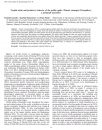| Nálezy podle období | |||||
|---|---|---|---|---|---|
| Oonopidae | 0-1900 | 1901-1950 | 1951-2000 | 2001+ | ∑ |
| Triaeris stenaspis Simon, 1892 | 2× | 2× | |||
Triaeris stenaspis Simon, 1892
| České jméno | vzokan skleníkový |
|---|---|
| Nálezy | 2 nálezů, 2 kvadrátů |
| První nález |
2017, V. Hula, |
| Poslední nález | 2019 , Ondřej Machač |
| Fytogeografická oblast | - |
| Původnost stanovišť | - |
| Vlhkost stanovišť | - |
| Stratum | - |
| Osvětlení stanovišť | - |
| Hojnost výskytu |
|
| Nadm. výška | 200-300 |
Literatura
Trophic niche and predatory behaviour of the goblin spider Triaeris stenaspis (Oonopidae): a springtail specialist?
Triaeris stenaspis Simon 1891 is a parthenogenetic goblin spider that has been introduced into greenhouses all over Europe. Here we investigated its trophic niche and predatory behavior. Potential prey in the greenhouses included predominantly springtails, aphids, and other spiders. Out of ten potential prey types offered in the laboratory, T. stenapsis captured only three types, the primary one being springtails. The spider rarely caught the other two types, termites and crickets, and completely rejected beetles, ants, aphids, thrips, flies, spiders and mites. Triaeris stenaspis did not build webs for prey capture, but instead used the grasp-and-hold tactic. Prey-capture efficiency decreased with springtail body size, the spider using more than three bites to capture large springtails. Large springtails defended themselves by saltation with the spiders still attached to their backs. Our study supports the hypothesis that Triaeris stenaspis is a specialized predator of springtails, being effective in the capture of this type of prey.
Life-history traits of the parthenogenetic oonopid spider, Triaeris stenaspis (Araneae:Oonopidae)
Selected life-history traits of an oonopid spider, Triaeris stenaspis Simon, which has been introduced into greenhouses in Europe, were investigated. Spiders were reared in the laboratory under constant physical and dietary conditions, and followed from egg to death. The spiders passed through 3 juvenile instars, each lasting approximately a month. The adult stage lasted on average 6 months, which is 54% of the entire life cycle. The mortality in each juvenile instar was similar. Five morphological characters were recorded for each instar, which provided a reliable means of identifying the developmental stages. All spiders developed into females and although kept isolated they laid fertile eggs, which indicates thelytokous parthenogenesis. Eggs were always enclosed in a disc-shaped egg-sac, each containing 2 eggs. Total fecundity was on average 27 eggs and rate of laying eggs decreased with age. Fecundity was positively correlated with adult longevity. Fertility was rather low, approximately 59%. It was negatively correlated with fecundity but not related to longevity. Low fertility appears to be the only cost of parthenogenetic reproduction. There was considerable genotypic variation in all traits studied compared to that in sexually reproducing spiders. There were no apparent maternal effects on all the traits studied. Using molecular methods proved that parthenogenesis in Triaeris stenaspis is not induced by the endosymbiotic bacteria, Wolbachia sp. or Cardinium sp.
Spiders (Araneae) of the family Oonopidae in the Czech Republic.
The oonopid spiders (Oonopidae), Tapinesthis inermis (Simon, 1882) and Triaeris stenaspis Simon, 1891, are recorded for the Czech Republic for the first time. Tapinesthis inermis was redetermined from misidentified material and Triaeris stenaspis was discovered in a greenhouse.Statistiky
Dle měsíce v roce
Dle nadmořské výšky
Dle metody sběru (2 použitých nálezů)
| Triaeris stenaspis Simon, 1892 | Samci | Samice | Mláďata | Nálezy |
|---|---|---|---|---|
| Individuální sběr | 0 | 1 | 0 | 1 |
| Neurčeno | 0 | 12 | 0 | 1 |
| Samci | Samice | Mláďata | Nálezy |
Dle biotopu (2 použitých nálezů)
| Triaeris stenaspis Simon, 1892 | Samci | Samice | Mláďata | Nálezy |
|---|---|---|---|---|
| Interiéry budov | 0 | 13 | 0 | 2 |
| Samci | Samice | Mláďata | Nálezy |





